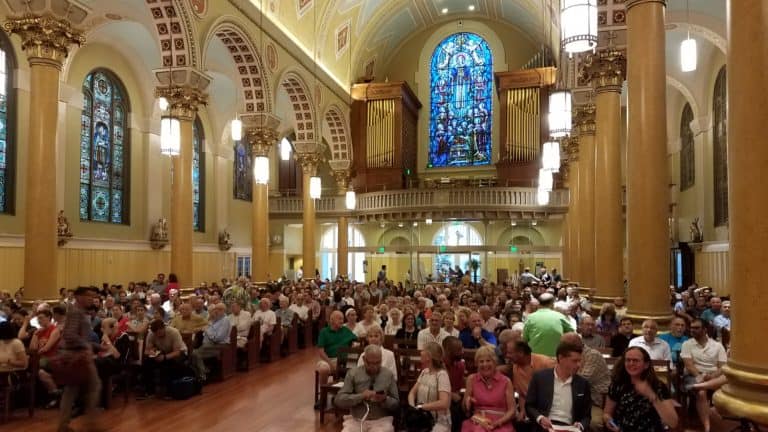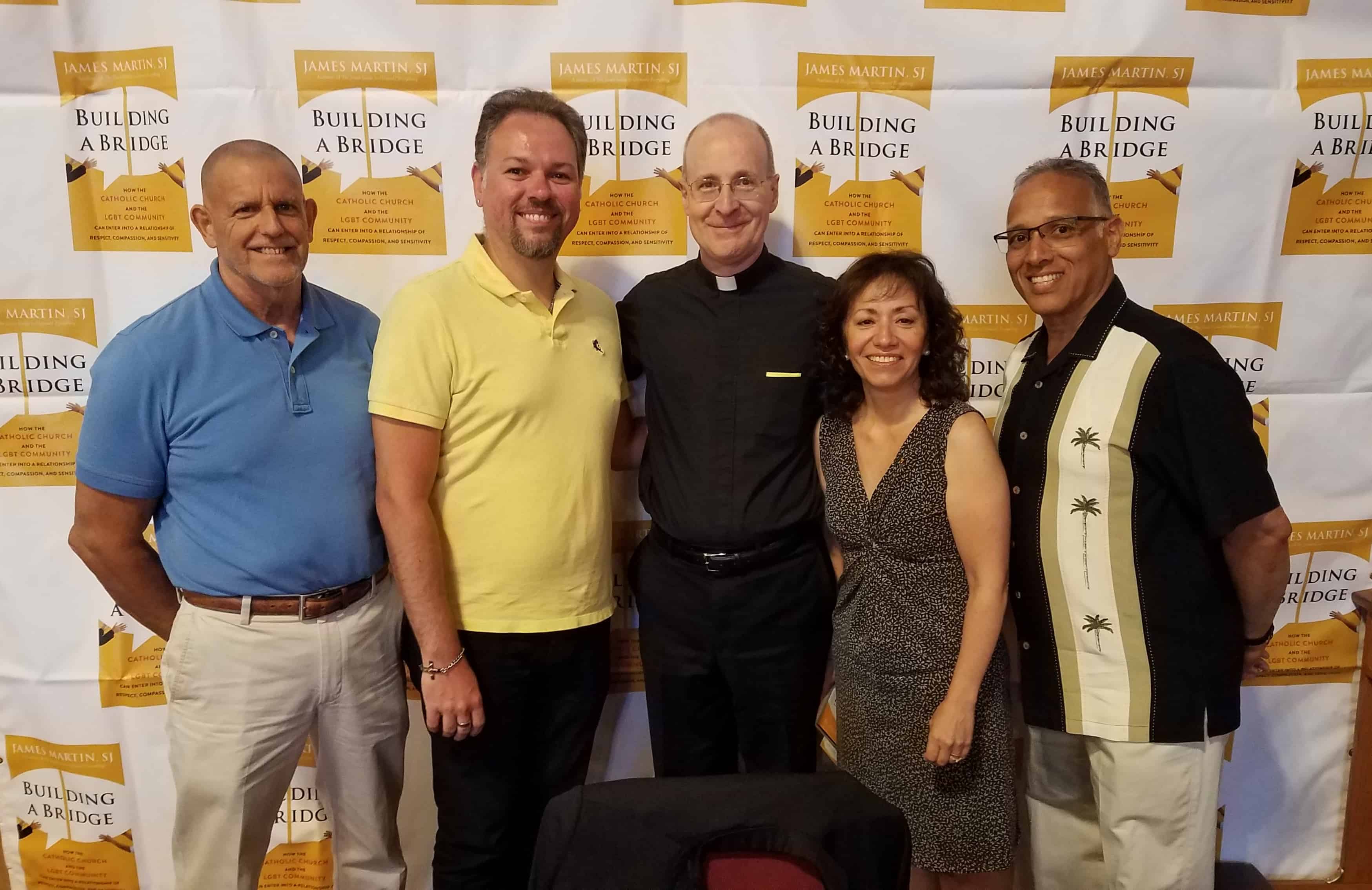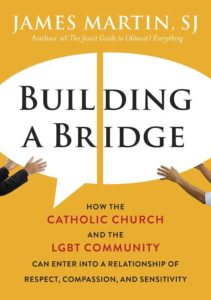This interview is Part I of a two-part series. Check here for the second half!
*****
TJP: Your book Building a Bridge: How the Catholic Church and the LGBT Community Can Enter into a Relationship of Respect, Compassion, and Sensitivity, has garnered a great deal of attention. What has that reception been like for your personally? Has anything about the reception surprised you?
Martin: The word that comes to mind is intense. The book has garnered some intense reactions. The most common are from LGBT people I’ve met at parish talks – in New York, New Jersey, Connecticut and Massachusetts – who cry when they talk to me or want to give me a hug. And the size of the crowds has also taken me aback. I think we had something like 700 people at St. Cecilia’s in Boston a few days after the book came out.
At first this really confused me. Because, frankly, the book is pretty mild. It doesn’t challenge any church teaching (it’s been approved by my provincial and endorsed by two cardinals, after all) and it doesn’t call for anything revolutionary. Its overarching theme is welcome, encounter and dialogue. Certainly those are things that people must have heard before. A diocesan priest friend of mine read the book, and said with a laugh, “Don’t take this the wrong way, Jim, but I read the book and wondered what all the fuss was about!”
It took a while to figure out the reason for the crowds and to understand the incredibly intense emotional reactions. I suspect it may come from hearing a priest saying these things. Seeing someone in a collar say these things, even if they are mild, may be new for people. It serves to remind me that there is still a hunger among LGBT Catholics for welcome from their own church. And when you’re in a collar that’s who you’re representing.
Another surprise has been the emotional reaction of parents and grandparents in particular. When I wrote the book, I imagined the target audience as two groups: LGBT Catholics and church officials. My aim was to build a bit of a bridge between them. But as more and Catholics are public about their sexuality and identity, the issue affects more Catholic families—parents, grandparents, aunts and uncles, brothers and sisters, and so on. I think that group has also felt for a long time the desire to be embraced by the church. So ministry to LGBT people is ministry to a much larger portion of the church than I imagined.
At the same time, the book has driven a few people, mainly online, into near hysteria. There have been some incredibly hateful comments from some websites; and the anger, contempt and ad hominem attacks have surprised me. Mind you, this goes beyond disagreement about the book and crosses into pretty clear homophobia, contempt and hatred. But I guess that’s what this community has had to deal with for many years.

Parishioners gather at St. Cecilia’s Church in Boston for Father James Martin’s talk on his book Building a Bridge, on June 19.
TJP: Your book has a specific goal: to encourage respectful, compassionate and sensitive dialogue between the LGBT community and the Catholic Church. It often seems that your critics, however, wanted something different from you – and tend to judge the book in light of their own goals. What are their goals? What have you learned from critics of your book? Have they shown you other bridges that need to be built?
Martin: That’s a good point. I told my publisher early on that I could probably anticipate the critiques from both sides. From some in the LGBT community it would be, “Not far enough.” From some in the institutional church, “Too far.”
As you point out, a lot of reviewers review the book that they wish had been written. Some reviewers wanted a book that said that the LGBT Catholics should never deal with the church, or never approach bishops with respect, which is a ridiculous position to take if you’re a Christian. Certainly they’ve been hurt, but reconciliation is always part of the Christian worldview. And some wanted a book that simply excoriated LGBT Catholics, or told them over and over and over how sinful they were, which I was also not going to do.
What are their goals? Among some on the far left, it seems to be a complete rejection of the church. Among some on the far right, it seems to be a complete rejection of LGBT people. What have I learned? That there can be common ground among people of reason and charity, but finding common ground with people with closed minds is harder. As for other bridges, I think that those who continually condemn LGBT people need to meet a few of them.
TJP: Explaining why you didn’t talk at length in your book about Church teaching on sexuality, you noted in a July 14 article that, “Theologically speaking, you could say that these teachings have not been “received” by the L.G.B.T. community, to whom they were directed. So I intentionally did not focus on those topics, since not only are those teachings well known, but they are also areas on which the two sides are too far apart. I preferred to focus on areas of possible commonality.”
What do you mean by “received” here? To what do you attribute this failure of reception? Is your approach of respect, compassion and sensitivity intended to ease that reception? What would do so?
Martin: To take a theological perspective, a teaching must be “received” by the faithful. It’s a complex topic (and I am no professional theologian) but, in general, for a teaching to be complete it must be appreciated, accepted and understood by the faithful. The tradition is that the faithful possess their own inner sense of the authority of a teaching. That’s the sensus fidei or sensus fidelium. You can find out more about it in the Vatican document Sensus Fidei. Here’s a quote that’s helpful:
The sensus fidei fidelis is a sort of spiritual instinct that enables the believer to judge spontaneously whether a particular teaching or practice is or is not in conformity with the Gospel and with apostolic faith.
This has always been part of church teaching. In any event, it seems like the majority of the LGBT Catholic community does not agree with the church’s teaching on same-sex relations: that is, they are impermissible. From what many LGBT people tell me, that particular teaching doesn’t fit with their own experiences as human beings who love and are loved. So that teaching, it seems, has not been “received” by the LGBT community, which is the community most affected by it.
Here’s an example: a longtime friend of mine named Mark, was in a religious order for a few years (not the Jesuits). After he left, he came out as a gay man, and entered into a relationship with another man. For the last 20 or so years, they’ve been together and Mark has also cared for him through a serious, long-term illness. So one question for the church is: Is that a form of love?
Thus, the “respect, compassion and sensitivity” that I’m calling for means that a bishop or church official would be open to meeting Mark, and his partner, and hearing what they have to say about their experience of love, and their receptivity to that teaching. That’s part of the bridge. What could a bishop learn from Mark? And what could Mark learn from a bishop?



